Abstract
The highly elevated concentrations of the rare earth elements and yttrium (REY), U, Mo, Se, and Pb in late Permian coals in some coalfields in Guangxi Province, South China, have been widely investigated; however, the mode of occurrence and enrichment mechanism of these critical elements are still under debate. This study investigates the mineralogical and geochemical compositions of coals and non-coal rocks from the Xian’an Coalfield in Guangxi Province to discuss the geological factors influencing the distribution of critical elements. The mineral in the studied coals consists mainly of quartz, and to a lesser extent, muscovite and kaolinite, with a trace amount of anatase. The coals are significantly enriched in REY, Pb, Se, Mo, and U and display the REY–U–Se–Mo–Pb-enrichment horizon (Horizon I) and U–Mo-enrichment horizon (Horizon II) adjacent to the host rocks or partings. The REY, U, Se, and Pb show organic association while Mo is primarily hosted by Fe-sulfides within Horizon I. The U and Mo have a phosphate affinity within Horizon II. Both the input of pyroclastic and epiclastic materials and the leaching of acidic solutions jointly govern the distribution of the REY–U–Se–Mo–Pb-enrichment horizon (Horizon I) and the U–Mo-enrichment horizon (Horizon II). The concentrations of REY in Horizon I exceed the cutoff grade of REY, and, therefore, the coals in the Horizon I can be regarded as promising raw materials of REY.
1. Introduction
Rare earth elements and yttrium (REY) in coals have attracted increasing attention in recent years [1,2,3,4,5], mainly due to the concentrations of REY in some coals close to or exceeding the cutoff grade of REY in coal ashes [6,7,8] and the supply shortage of conventional types of REY ore since 2009 [7]. Moreover, the REY-rich coals are mostly enriched in critical REY (Nd, Eu, Tb, Dy, Y, and Er), which could alleviate the raw materials crisis of critical REY in the near future [7]. Therefore, the REY-rich coals can be regarded as alternative REY raw materials [1,7].
REY-rich coals and host rocks are extensively investigated in some coalfields worldwide, mainly in China [1,2,5,9,10,11,12,13,14,15,16,17,18,19,20,21,22], Russia [6,7,23,24,25,26], and America [4,27,28,29,30,31]. The highly elevated concentrations of REY in these coals are commonly caused by the input of epiclastic materials, pyroclastic materials, groundwater, and hydrothermal fluids [7,8]. In most cases, multiple geological factors jointly govern the abnormal enrichment of REY in the REY-rich coals [5,7,18,32].
The late Permian is an important coal-forming period in Guangxi Province, South China. The mineralogy and geochemistry of the late Permian coals in Guangxi Province have been investigated mainly in Heshan Coalfield [33,34,35], Yishan Coalfield [1], and Fusui Coalfield [33]. The coals present in these coalfields are superhigh-organic-sulfur coals and are enriched in Mo, U, Se, and V [1,2,33,34,35]. The influx of hydrothermal fluids is considered as a possible geological factor responsible for the Mo–U–Se–V enrichment in the coals [1,2]. Moreover, the highly enriched REY concentrations were also found in the coals from the Yishan Coalfield and are attributed to the injection of high-temperature solutions [1]. The Xian’an Coalfield contains relatively abundant coal resources, but the geochemical compositions of the coals from this coalfield are rarely investigated. Whether or not the rare metals are enriched in the coals in the Xian’an Coalfield is still unclear. This study investigates the mineralogy and geochemistry of the late Permian coals and non-coal rocks in the Xian’an Coalfield, Guangxi Province, China, with an emphasis on the geological controls on the geochemical anomaly in the coals. It also provides an opportunity to determine whether the coals in the Xian’an Coalfield can be considered as promising raw materials for certain rare metals.
2. Geological Setting
The late Permian is an important coal-forming period in Guangxi Province, China (Figure 1A). The late Permian coalfields in Guangxi Province mainly include the Heshan, Fusui, Yishan, Xian’an, Baiwang, and Qianjiang coalfields. The Xian’an coalfield is located in the middle part of Guangxi Province, southern China (Figure 1B). The coalfield covers an area about 8 km wide (W–E direction) and 35 km long (N–S direction) and includes Beigeng, Wanfu, Qianxian, and Mushan exploration regions (Figure 1C).
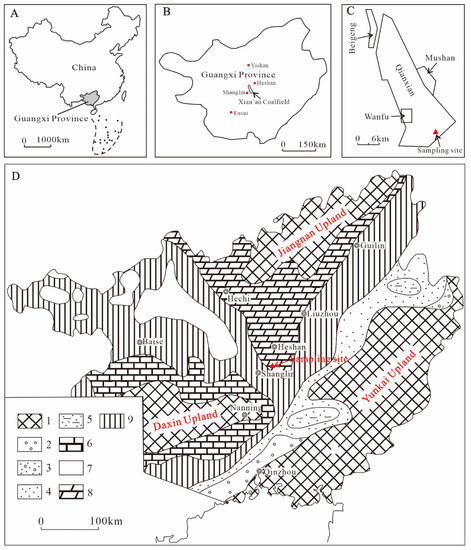
Figure 1.
Maps of the study area: (A) Map of China showing the location of Guangxi Province, China. (B) Location of the Xian’an Coalfield. (C) Location of the coal exploration region. (D) Paleogeography of the late Permian period modified from [38]. 1—upland, 2—fluvial facies, 3—fluvial estuary facies, 4—clastic tidal facies, 5—lagoon, 6—lagoon-isolated carbonate platform, 7—isolated carbonate platform, 8—peat mire, 9—deep-water pyroclasts, siliceous rocks basin.
During the early–middle Permian, South China including Guangxi Province was covered by thick marine deposits of carbonate strata such as the Maokou Formation [36]. Due to crustal uplift caused by the arrival of the Emeishan mantle plume [37], the Maokou Formation is subjected to different degrees of weathering, leaching, and erosion, thereby leading to the development of claystone or bauxite at the top of the Maokou Formation. Subsequently, the marine transgression occurred during the late Permian and deposited carbonate rocks, epiclastic rocks, and coal seams. During the doming of the Emeishan mantle plume, the Yunkai Upland and Daxin Upland began to uplift and ultimately evolved into a topographic highland during the late Permian (Figure 1D) [36,38]; the Yunkai Upland provides the predominant detrital materials into the late Permian coalfields including the Yishan, Heshan, Xian’an, and Fusui coalfields, which are located in eastern Guangxi Province [1,33,36].
The late Permian coal-bearing stratum in the Xian’an coalfield is primarily the Heshan Formation, with a thickness ranging from 98 to 220 m. The Heshan Formation unconformably overlies the middle Permian Maokou Formation and conformably underlies the late Permian Dalong Formation (Figure 2A). Based on the lithological and coal-bearing characteristics, the Heshan Formation is subdivided into the upper and lower sections. The lower section of the Heshan Formation consists mainly of clayey stones, flint limestones, bioclastic limestones, and a coal seam, with an average thickness of 17.4 m; the upper section is primarily composed of flint limestones interbedded with mudstones, coal seams, sandstones (Figure 2A).
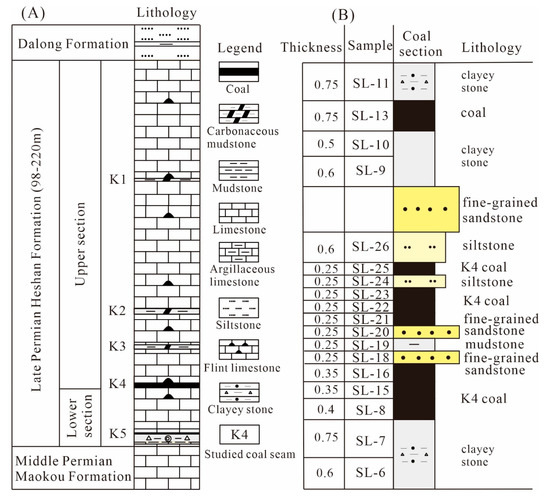
Figure 2.
(A) The generalized stratigraphic column of the Xian’an Coalfield. (B) Sampling column of the outcrop section.
The Heshan Formation contains five coal seams in the Xian’an coalfield, namely K1, K2, K3, K4, and K5 (Figure 2A). Among these, the K1, K2, and K3 coals are mostly carbonaceous mudstone interbedded with a thin coal seam, and their thickness ranges from 0.1 to 0.3 m, 0.7 to 4.3 m, and 0.4 to 4.5 m, respectively; the K4 coal is the primary workable coal seam, and its thickness ranges from 0.3 to 6.2 m, with an average of 2.1 m; the K5 coal is an unworkable coal seam and is intercalated into the clayey rocks.
3. Methodology
Eighteen samples, including eight coal samples and ten non-coal samples, were collected from the outcrop section in the Qianxian exploration region of Xian’an Coalfield in Guangxi Province, SW China (Figure 1B,C and Figure 2B). The weathered layer of the outcrop section was first removed before sampling to reduce the influence of chemical weathering on mineralogical and geochemical constituents. The studied samples were cut over an area 10 cm wide and 10 cm deep, and then, were put in plastic bags to avoid contamination and oxidation.
The studied samples were ground to ≤0.2 mm and split into two representative portions. A portion of the sample (<0.2 mm) was directly used for proximate analysis based on the ASTM Standards D3173-11 (2011), D3174-11 (2011), and D3175-11 (2011) [39,40,41], while another representative portion was ground further to ≤0.076 mm (200 mesh) using an agate mortar and pestle for mineralogical and geochemical analysis. The total sulfur content in the studied samples was determined following ASTM Standard D3177-02 (2002) [42]. Mineralogical analyses of the sample powders were performed by powder X-ray diffraction (XRD) using a Bruker D8 A25 Advance (Bruker D8 A25 Advance, Leipzig, Germany) at the Institute of Environmental Assessment and Water Research (Spain). The detailed XRD analysis procedure and semiquantitative analysis were reported in a previous study [32]. The diffractograms were obtained at 40 kV and 40 mA by scanning at a 2θ interval of 4–60°, with a step size of 0.019° and a counting time of 0.1 s/step and the sample under rotation of 15/min. Semiquantitative XRD analysis was performed by using the matrix-flushing method devised by Chung [43] and calculating the integrated area of the main peak for the different mineral phases in each sample. This method first requires the calculation of the XRD constants for each crystalline phase by applying the Klug and Alexander equation [44]. Subsequently, the material under study is spiked with the internal standard and analyzed by XRD to obtain the proportions of each crystalline phase of the sample.
Approximately 0.1 g of coal sample was weighed and digested based on the method proposed by Querol et al. [45] for geochemical analysis. Major elements (Al, Ti, Fe, Mg, Ca, Na, K, and P) and trace elements were identified by inductively coupled plasma–atomic-emission spectrometry (ICP-AES, Iris Advantage TJA Solutions, Thermo Fisher Scientific, Waltham, MA, USA) and inductively coupled plasma–mass spectrometry (ICP-MS, X-Series II Thermo, Thermo Fisher Scientific, Waltham, MA, USA). Silicon content was measured by wavelength-dispersive X-ray fluorescence spectrometry (XRF; ZSX Primus II) following the methods for chemical analysis of silicate rocks [46].
A small portion of representative block samples was used to prepare the polished sections for the SEM-EDS analysis. The modes of occurrence of minerals were studied using a field-emission scanning electron microscope (ZEISS Sigma300, Carl Zeiss AG, Jena, Germany), equipped with an energy-dispersive X-ray spectrometer (EDS) in the State Key Laboratory of Geological Processes and Mineral Resources (China).
4. Results
4.1. Standard Coal Characteristics
The moisture contents, ash yields, volatile matter yields, and sulfur contents of the coal samples are tabulated in Table 1. The moisture contents range from 2.2% to 14.3% with an average of 10.0%. The ash yields of the coal samples vary between 36.4% and 79.7% with an average of 52.5%. The high ash yield of the coal samples is due to exposure and chemical weathering of the coals along the outcrop profile. The volatile matter yields of the coal samples range from 22.9% to 56.4%, with an average of 41.1%. The high volatile matter yields in the coal samples are ascribed to relatively high ash yields, which contribute to some proportion of volatile matter as indicated by the linear correlation of volatile matter and ash yield (r = 0.81) in coal samples except for sample SL-13. Previous coalfield exploration data show that the coals from the Xian’an Coalfield have 10–18% volatile matter yield, indicating low-volatile bituminous coals.

Table 1.
Thickness (m), proximate analysis (wt.%), and sulfur content (%) of the coal samples from the outcrop profile in the Xian’an Coalfield.
The total sulfur contents in the coal samples vary from 1.1% to 3.1% with an average of 1.9%, indicating medium sulfur coal (<1.0%, 1.0–3.0%, and >3.0% for low, medium, and high-S coals, respectively) [47].
4.2. Mineralogy
4.2.1. Mineral Phases
The proportions of crystalline mineral phases in samples are summarized in Table 2. The minerals in coal samples mainly consist of quartz, and to a lesser extent, muscovite and kaolinite, with a trace amount of anatase (Figure 3). Hematite is only identified in sample SL-13. The sandstone samples, including samples SL-18, SL-20, SL-24, and SL-26, are characterized by a high level of quartz, with minor proportions of kaolinite, dickite + kaolinite, and muscovite (Figure 3). The claystone samples SL-6 and SL-7 are composed predominantly of kaolinite with minor amounts of anatase while claystone samples SL-9, SL-10, and SL-11 consist almost exclusively of dickite + kaolinite with minor amounts of anatase and pyrite (Figure 3). The minerals in mudstone sample SL-19 consist primarily of quartz, rectorite, and muscovite, with minor kaolinite and trace of anatase.

Table 2.
Mineralogical proportions of the coal and non-coal samples determined by X-ray diffraction (XRD) from the outcrop profile in the Xian’an Coalfield (on whole-coal basis; unit in %).
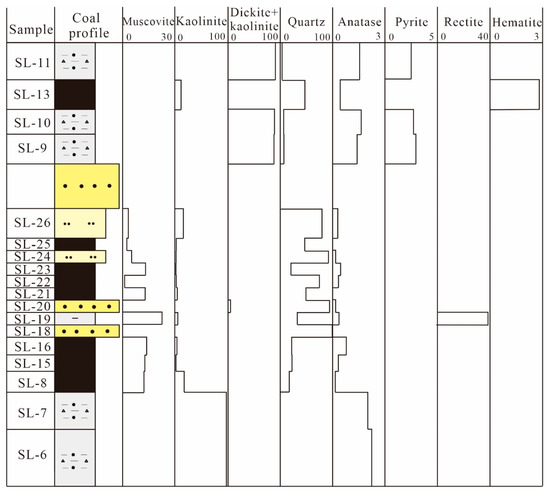
Figure 3.
Vertical distribution of minerals throughout the outcrop profile.
Dickite is a polytype of kaolinite and has the same chemical composition as kaolinite, but they can be distinguished by the XRD pattern. Dickite can be distinguished from kaolinite by the presence of diffraction peaks of 3.95, 3.79, and 3.43 Å (sample SL-11; Figure 4). However, relatively low intensities of 3.95, 3.79, and 3.43 Å appear to indicate a complex of dickite and kaolinite. Thus, this mineral phase is reported as dickite + kaolinite in the XRD results. Most claystone and coal samples have poorly ordered kaolinite (e.g., samples SL-6, SL-8) (Figure 4), indicating a detrital origin [48,49]. However, sample SL-7 immediately adjacent to the coal bench (sample SL-8, Figure 3) shows an increasing kaolinite crystallinity, which is characterized by the weak diffraction of (020) as well as the presence of six diffraction peaks of kaolinite from 20° to 25° (2θ) and from 35° to 40° (2θ), respectively (Figure 4); this relatively well-ordered kaolinite is most likely caused by acidic solutions from the degradation of organic matter, which allow inorganic materials to be degraded and recrystallized.
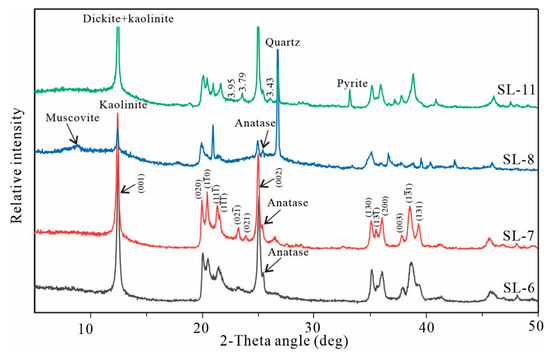
Figure 4.
X-ray diffraction (XRD) patterns of minerals in selected samples.
4.2.2. Mode of Occurrence of Minerals
Pyrite was identified in samples SL-9, SL-10, and SL-11 by XRD analysis. Pyrite primarily occurs as individual euhedral crystals, with eroded cavities within them (Figure 5A); this form of pyrite is considered to be formed by direct interaction of Fe2+ with HS− [47]. To a lesser extent, pyrite was found as massive form (Figure 5B) and framboidal aggregates (Figure 5B) within the kaolinite matrices.
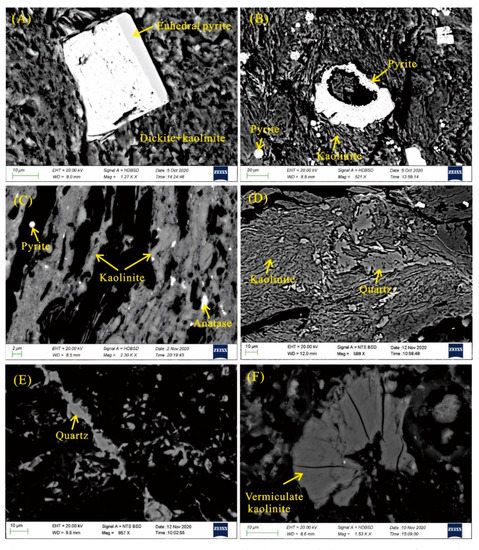
Figure 5.
Scanning electron microscope (SEM) back-scattered electron images of minerals (A–F). (A) Euhedral pyrite embedded within dickite matrix (sample SL-9); (B) massive pyrite, framboidal pyrite, and kaolinite matrix (sample SL-9); (C) kaolinite layers and lenses, combined with fine-grained disseminated anatase particles (sample SL-16); (D) kaolinite matrix and quartz-filled cavities (sample SL-13); (E) fracture-filled quartz (sample SL-16); (F) vermiculate kaolinite (sample SL-25).
Kaolinite primarily occurs as thin layers or lenses (Figure 5C) and as a kaolinite matrix (Figure 5D), all of which indicate that kaolinite was mechanically transported as a detrital input into paleomire. The detrital kaolinite is also confirmed by the XRD patterns, which show the abundant existence of poorly ordered kaolinite (Figure 4). Moreover, vermiculate kaolinite was also observed in the studied coals (Figure 5F).
Quartz is found as cavities and fracture infillings within the organic matter (Figure 5E), and cavity infillings within the kaolinite matrix (Figure 5D), all of which indicate authigenic precipitation of Si-rich fluids. Fine-grained disseminated anatase particles were identified within the kaolinite matrix (Figure 5C), and the size of anatase was mostly <10 μm.
4.3. Geochemistry
4.3.1. Major Elements
The major elemental contents of the coal and non-coal samples collected from the outcrop profile are listed in Table 3. SiO2 and to a lesser extent, Al2O3 are the major inorganic components in the coal samples, as would be expected from mineral assemblage (quartz–muscovite–kaolinite) (Table 2). Furthermore, the claystone samples (sample SL-6, SL-7, SL-9, SL-10, and SL-11) are dominated by SiO2 and Al2O3 due to kaolinite- and dickite-bearing mineral fractions. SiO2 is almost exclusively an inorganic constituent in the sandstone samples (sample SL-18, SL-20, SL-24, and SL-26) due to the quartz-bearing mineral fraction. Compared with Chinese coals reported by Dai et al. [10], the proportions of SiO2 and K2O in coal samples are evidently higher than those in Chinese coals due to the abundant occurrence of quartz and aluminosilicate minerals (e.g., muscovite); the remaining major elements are similar in abundance to those in Chinese coals.

Table 3.
Major-element oxides (%) of the coal and non-coal samples from the outcrop profile in the Xian’an Coalfield (on whole-coal basis).
The SiO2/Al2O3 ratio in the coals (2.3–10.8, 5.7 on average) and sandstone samples (6.4–123.1, 40.2 on average) are significantly higher than that in claystone samples (1.2–1.4, 1.3 on average); this result is in accordance with the mineral assemblage in them. The K2O/Al2O3 ratios in the coals (0.08–0.14, 0.11 on average) and sandstone (0.08–0.27, 0.11 on average) are higher than those in claystone (0.006–0.034, 0.018 on average) due to the presence of aluminosilicate minerals (e.g., muscovite) in the coals and sandstones.
4.3.2. Trace Elements
The trace element contents of the coal and non-coal samples collected from the outcrop profile are listed in Table 4. The concentration coefficient (CC) is used in the present study to conveniently describe the degree of enrichment or depletion of trace elements; the CC is a ratio of the coal samples versus world hard coals reported by [50], with CC <0.5, 0.5–2, 2–5, 5–10, and >10 indicative of depletion, similarity, slight enrichment, enrichment, and significant enrichment, respectively [51]. Compared with world hard coals [50], the studied coals are significantly enriched in V, Se, Mo, Ce, Sm, and U, enriched in As, Cs, La, Pr, Eu, Gd, Tb, Dy, Ho, Er, Yb, Lu, and Pb, slightly enriched in Sc, Cu, Ga, Zr, Nb, Sn, Tm, Hf, and Th, and depleted in B, Mn, Co, Ni, Sr, and Ba; other trace elements are similar to the corresponding averages of world hard coals (Figure 6). Therefore, the studied coals contain highly elevated concentrations of the REY–V–Se–Mo–U assemblage.

Table 4.
Trace element concentrations (μg/g) of the coal and non-coal samples from the outcrop profile in the Xian’an Coalfield (on whole-coal basis).
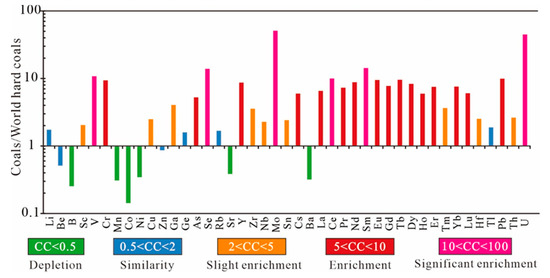
Figure 6.
Concentration coefficient (CC) of trace elements in the studied coals, normalized to the respective average of world hard coals [28].
4.3.3. Rare Earth Elements and Y (REY)
A threefold geochemical classification (LREY, MREY, and HREY) and the three enrichment types (L-type, M-type, and H-type) of REY proposed by Seredin and Dai [7] as well as the upper continental crust [52]–normalized REY pattern were used in the present study to monitor the fractionation among REY. The Upper Continental Crust (UCC)–normalized REY patterns show an H-type REY distribution pattern in coal benches SL-8, SL-15, SL-16, and SL-13 (Figure 7A) and an M-type REY pattern in coal benches SL-21, SL-22, SL-23, and SL-25 (Figure 7B), possibly indicating the influence of aqueous solutions [5,53]. The coal samples exhibit slightly negative Eu anomalies (Figure 7A,B), indicating contributions from felsic compositions [53]. The coal benches showing an H-type REY pattern display essentially no Ce anomalies (Figure 7A) while coal benches showing an M-type REY pattern exhibit slightly positive Ce anomalies (Figure 7B).

Figure 7.
Distribution patterns of rare earth elements and yttrium (REY) in the studied coals (A,B). REY are normalized to the upper continental crust [52].
5. Discussion
5.1. Source of Detrital Materials
The Al2O3/TiO2 ratio is widely utilized to infer the geochemical composition of detrital materials transported or blown into peat mires [5,18,28,54] due to little fractionation of both elements during geological process [55], with 3–8, 8–21, and 21–70 indicative of mafic, intermediate, and felsic igneous rocks, respectively [55]. The coal and non-coal samples all fall into the field of intermediate-felsic rocks (Figure 8), indicating that detrital materials in coal-bearing basins are geochemically dominated by intermediate-felsic compositions. Moreover, the input of intermediate-felsic constituents is also further supported by the slightly negative Eu anomalies in the studied coals (0.67–0.79) (Figure 7A,B) because the UCC-normalized negative Eu anomalies in coals are thought to represent contributions from felsic constituents [15].
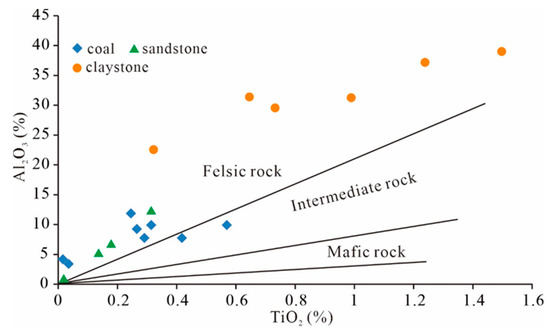
Figure 8.
The plot of TiO2 versus Al2O3 contents for the coal and non-coal samples.
The previous studies demonstrate that the Yunkai Upland is the dominant sediment-source region and provides terrigenous felsic detrital materials into the late Permian coal-bearing basin in Guangxi Province, China [1,2,33,36]. During the deposition of late Permian coal-bearing strata, the Xian’an Coalfield was located in the margin of the isolated carbonate platform and bounded to the south by a deep-water basin (Figure 1D). This appears to denote that detrital materials from the Yunkai Upland are rarely mechanically transported into the Xian’an Coalfield. Additionally, the detrital materials in the Xian’an Coalfield are possibly derived from the weathering residues (immediately above the Maokou Formation limestone) within the coastal zone, which were transported into the peat mire by seawater during the formation of the coal-bearing stratum. In this case, detrital calcite and dolomite grains are generally associated with the clay matrices [56]. However, the carbonate mineral phases cannot be identified in the coals by the XRD and SEM-EDS analysis, indicating a negligible detrital input from the adjacent weathering crust directly above the Maokou Formation limestone. Furthermore, the morphological characteristics of kaolinite matrices shown in Figure 5 are similar to those of the pyroclastic materials as reported in previous studies [57,58,59,60], appearing to indicate the pyroclastic input into the paleomires. The input of pyroclastic materials is also supported by the following evidence: (1) the presence of vermiculate kaolinite (Figure 5F), which is usually originates from the transformation of volcanic ash [5,60], and (2) the abundant occurrence of synchronous pyroclastic materials, which are deposited in the late Permian strata close to the studied region [38]. Thus, the input of pyroclastic materials is a possible source for the inorganic constituents in the late Permian Heshan Formation.
5.2. Origin of Highly Elevated Concentrations of the REY–Se–Pb–Mo–U Assemblage
There is a REY–Se–Pb–Mo–U-enrichment horizon (Horizon I) immediately overlying the sandstone throughout the outcrop section (Figure 9). In Horizon I, the REY, Se, Pb, Mo, and U contents are up to 1013, 38, 123, 72, and 81 μg/g, respectively; the REY negatively correlates with ash yield (r = −0.99) and show essentially no correlations with Al2O3 (Figure 9), P2O5, and Zr, thereby appearing to indicate an organic association; this result differs from previous studies showing that the REY in some REY-rich coals is mostly likely hosted by phosphates, heavy minerals, and clay minerals [5,7,56]. Moreover, Horizon I is characterized by a high degree of REY enrichment and normal levels of Zr, Hf, Nb, and Ta, appearing to exclude the possibility of the input of alkaline volcanic ash due to them being enriched in the REY–Zr (Hf)–Nb (Ta) assemblage [5,7,60,61,62,63,64]. Furthermore, the highly elevated concentrations of REY in Horizon I, however, are accompanied by elevated contents of Se, U, Mo, and Pb; this assemblage most commonly represents the influx of metal-bearing solutions [7]. It is noteworthy that the highly elevated REY concentrations in Horizon I are jointly controlled by both the input of felsic epiclastic and pyroclastic detrital materials, and the subsequent leaching of acidic solutions based on the following evidence. As mentioned above, the terrigenous detrital materials from the Yunkai Upland are dominated by felsic compositions, which can provide relatively high background values of incompatible elements such as REY. This result is also further substantiated by the fact that the parting (sample SL-24) and roof (sample SL-26) contain REY contents (353 and 481 μg/g, respectively) distinctly higher than the upper crust composition (UCC) (168 μg/g) [52]. Moreover, the coals from the Yishan, Heshan, and Fusui coalfields that have the same sediment source region as the studied coals, are characterized by the relatively enhanced contents of REY [2,16,33], also supporting the input of REY-rich felsic terrigenous detrital materials. Moreover, the pyroclastic input from the adjacent regions also supplies abundant inorganic constituents into the coal-bearing strata as discussed previously. Subsequently, the pyroclastic and epiclastic materials that were deposited as parting and roof were subjected to the intense leaching of acidic solutions, which causes the breakdown of REY–Se–U–Mo–Pb-bearing detrital minerals. Consequently, the leachates derived from the host rocks or parting migrate upward or downward into the adjacent coal benches and were then re-deposited as authigenic minerals or adsorbed onto clay minerals or organic matter under anoxic conditions as reported elsewhere [56]; this process is supported by the Zr/Hf ratio, which shows a higher value in the coal benches than in the parting (sample SL-24) and roof (sample SL-26) (Figure 9), mainly because Zr is more easily mobilized than Hf during the activity of acidic solutions as reported in previous studies [5,33]. This is also supported by the cleat/fracture infilling of quartz, which most likely originates from the epigenetic precipitation of Si-rich solutions through leaching processes during coalification. Due to the low migration capacity of REY, the REY-rich leachates shortly migrate, and thus the REY-enrichment horizon is confined to Horizon I (Figure 9); this result is consistent with previous studies [5,23]. The REY displays similar distribution to that of Se, U, and Pb, which is most likely because these elements are synchronously leached from the same detrital materials (roof and parting), and then REY–Se–U–Pb-bearing leachates simultaneously precipitate into the adjacent coal benches.
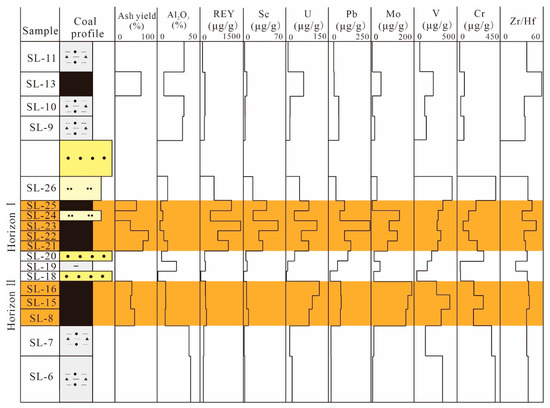
Figure 9.
Vertical distribution of ash yield, selected elements, and element ratios throughout the outcrop profile.
In Horizon I, U, Se, and Pb significantly positively correlate with each other, possibly reflecting that they have the same carrier; however, they show essentially no correlations with S and Fe2O3 but strongly negative correlations with ash yield (Figure 9), apparently pointing to an organic association. As reported above, the U–Se–Pb-bearing solutions, which are leached from the host rocks and partings, flow and ultimately precipitate into coal benches due to the reduction of organic matter during coalification. This process can better explain why the U-enrichment horizons are closely adjacent to the host rocks and parting throughout the outcrop profile (Figure 9). By contrast, the distribution of Mo differs from that of U, Se, and Pb, indicating various carriers; Mo is positively correlated with Fe2O3 (r = 0.90), appearing to indicate that the Fe-sulfides are the major host of Mo. Fe-sulfides (e.g., pyrite) predominantly occur as euhedral crystals, indicating a syngenetic origin. Thus, Mo involved within pyrite is most likely hosted during peat accumulation or the early diagenetic stage under anoxic conditions. The contents of V and Cr are strikingly higher in the host rocks (samples SL-26 and SL-20) compared to that in the coal benches in Horizon I, suggesting a detrital input, which is consistent with the previous studies [56].
There is a Mo–U-enrichment horizon (Horizon II) below the sandstone layer (Figure 9). In Horizon II, the contents of Mo and U are up to 174 and 98 μg/g, respectively. The U and Mo display a similar distribution and an increasing, upward tendency toward the roof rocks (sample SL-18). The U (r = 0.99) and Mo (r = 0.99) significantly positively correlate with CaO, and CaO and P2O5 significantly correlate with each other. This appears to denote that the U and Mo are hosted by the phosphate phases (e.g., apatite), and their derivation is possibly from the leaching of pyroclastic materials within the roof rocks (sample SL-18).
5.3. Potential Economic Significance of REY in the Coals and Non-Coal Rocks
Total REY contents and individual REY compositions in coals are important for evaluating the economic recovery of REY. Seredin and Dai [7] proposed that the cutoff grade of REY oxides (REO) in coal ashes is 1000 μg/g. For REY-rich coal ashes, the outlook coefficient (Coutl) was used to determine the economic potential of REY, and its calculation follows Equation (1), with >2.4, 0.7–2.4, and <0.7 indicative of highly promising, promising, and unpromising REY raw materials, respectively [1,7,16]. Moreover, the Coutl-REO graph was also utilized to evaluate the REY economic potential [15].
The REO concentrations in coal ashes and non-coal rocks are plotted as a function of Coutl in Figure 10, where the REO contents of coal ashes in Horizon I (samples SL-21, SL-22, SL-23, and SL-25) range from 899 to 4503 μg/g and their average (2398 μg/g) exceeds the cutoff grade (1000 μg/g; Seredin and Dai, 2012), indicating that the coals in Horizon I can be regarded as promising raw materials of REY (Figure 10). However, the REO concentrations of other coal seams (samples SL-8, SL-13, SL-15, and SL-16) (320–613 μg/g) and non-coal rocks (11–567 μg/g) are much lower than the cutoff grade of REY in coal ash, suggesting that these coals and non-coal rocks are not seen as raw materials of REY.

Figure 10.
Evaluation of REY in coal ash and non-coal rocks from the Xian’an Coalfield.
Although the investigated coals are highly enriched in U, Mo, Se, and V, the concentrations of U (68–302 μg/g, 184 μg/g on average), Mo (9–472 μg/g, 233 μg/g on average), Se (9–157 μg/g, 46 μg/g on average), and V (361–1128 μg/g, 629 μg/g on average) in coal ashes are much less than the suggested cutoff grade of U (1000 μg/g), Mo (1000 μg/g), Se (500–800 μg/g), and V (1000 μg/g) [1], suggesting these critical elements cannot be economically extracted from the coals.
6. Conclusions
The coals from the outcrop profile in the Xian’an Coalfield, Guangxi Province, South China, show the REY (1013 μg/g)–Se (38 μg/g)–Pb (123 μg/g)–Mo (72 μg/g)–U (81 μg/g)-enrichment horizon (Horizon I) and Mo (174 μg/g)–U (98 μg/g)-enrichment horizon (Horizon II). In Horizon I, REY, Se, Pb, and U are intimately associated with organic matter while Mo is hosted by Fe-sulfides (e.g., pyrite). In Horizon II, the Mo and U are hosted within phosphate phases. The highly elevated concentrations of REY, Se, Pb, Mo, and U are derived from the input of pyroclastic and epiclastic materials. However, the leaching of acidic solutions allows the inorganic materials to be degraded and soluble REY, Se, Pb, Mo, and U to be migrated and redistributed, leading to higher contents of REY, Se, Pb, Mo, and U in the coal benches immediately adjacent to the roof and partings. The coals in Horizon I can be regarded as promising raw materials of REY.
Author Contributions
F.Z., B.L., X.Z., X.Q., Y.S., J.Z. and J.L. collected the samples; X.Q. and N.M. conducted the experiments; F.Z. and B.L. wrote the original draft; X.Q., X.Z., and B.L. revised and edited the manuscript. All authors have read and agreed to the published version of the manuscript.
Funding
This study was funded by the National Science Foundation of China (no. 41972182), the National Science Foundation of Guangxi Province (no. 2018JJA150165), the “Overseas Top Scholars Program”, part of the “Recruitment Program of Global Experts” (no. G20190017067), and the Key Laboratory of Tectonics and Petroleum Resources (TPR-2018-16).
Institutional Review Board Statement
Not applicable.
Informed Consent Statement
Not applicable.
Data Availability Statement
Not applicable.
Acknowledgments
The authors would like to give their sincere thanks to the Guangxi Bureau of Coal Geology for assistance during sampling and to the Institute of Environmental Assessment and Water Research, CSIC, Spain, for assistance during the sample analysis.
Conflicts of Interest
The authors declare no conflict of interest.
References
- Dai, S.; Finkelman, R.B. Coal as a promising source of critical elements: Progress and future prospects. Int. J. Coal Geol. 2018, 186, 155–164. [Google Scholar] [CrossRef]
- Dai, S.; Ren, D.; Zhou, Y.; Seredin, V.V.; Li, D.; Zhang, M.; Hower, J.C.; Ward, C.R.; Wang, X.; Zhao, L.; et al. Coal-hosted rare metal deposits: Genetic types, modes of occurrence, and utilization evaluation. J. China Coal Soc. 2014, 39, 1707–1715, (In Chinese with English Abstract). [Google Scholar]
- Hower, J.C.; Granite, E.J.; Mayfield, D.B.; Lewis, A.S.; Finkelman, R.B. Notes on contributions to the science of rare earth ele-ment enrichment in coal and coal combustion byproducts. Minerals 2016, 6, 32. [Google Scholar] [CrossRef]
- Hower, J.C.; Qian, D.; Briot, N.J.; Hood, M.M.; Eble, C.F. Mineralogy of a rare earth element-rich Manchester coal lithotype, Clay County, Kentucky. Int. J. Coal Geol. 2020, 220, 103413. [Google Scholar] [CrossRef]
- Li, B.; Zhuang, X.; Querol, X.; Moreno, N.; Córdoba, P.; Shangguan, Y.; Yang, L.; Li, J.; Zhang, F. Geological controls on the distribution of REY-Zr (Hf)-Nb (Ta) enrichment horizons in late Permian coals from the Qiandongbei Coalfield, Guizhou Province, SW China. Int. J. Coal Geol. 2020, 231, 103604. [Google Scholar] [CrossRef]
- Seredin, V.V.; Finkelman, R.B. Metalliferous coals: A review of the main genetic and geochemical types. Int. J. Coal Geol. 2008, 76, 253–289. [Google Scholar] [CrossRef]
- Seredin, V.V.; Dai, S. Coal deposits as potential alternative sources for lanthanides and yttrium. Int. J. Coal Geol. 2012, 94, 67–93. [Google Scholar] [CrossRef]
- Seredin, V.V.; Dai, S.; Sun, Y.; Chekryzhov, I.Y. Coal deposits as promising sources of rare metals for alternative power and energy-efficient technologies. Appl. Geochem. 2013, 31, 1–11. [Google Scholar] [CrossRef]
- Dai, S.; Zhou, Y.; Ren, D.; Wang, X.; Li, D.; Zhao, L. Geochemistry and mineralogy of the Late Permian coals from the Songzo Coalfield, Chongqing, southwestern China. Sci. China Ser. D Earth Sci. 2007, 50, 678–688. [Google Scholar] [CrossRef]
- Dai, S.; Ren, D.; Chou, C.-L.; Finkelman, R.B.; Seredin, V.V.; Zhou, Y. Geochemistry of trace elements in Chinese coals: A re-view of abundances, genetic types, impacts on human health, and industrial utilization. Int. J. Coal Geol. 2012, 94, 3–21. [Google Scholar] [CrossRef]
- Dai, S.; Zhang, W.; Ward, C.R.; Seredin, V.V.; Hower, J.C.; Li, X.; Song, W.; Wang, X.; Kang, H.; Zheng, L.; et al. Mineralogical and geochemical anomalies of late Permian coals from the Fusui Coalfield, Guangxi Province, southern China: Influences of terrigenous materials and hydrothermal fluids. Int. J. Coal Geol. 2013, 105, 60–84. [Google Scholar] [CrossRef]
- Dai, S.; Luo, Y.; Seredin, V.V.; Ward, C.R.; Hower, J.C.; Zhao, L.; Liu, S.; Zhao, C.; Tian, H.; Zou, J. Revisiting the late Permian coal from the Huayingshan, Sichuan, southwestern China: Enrichment and occurrence modes of minerals and trace elements. Int. J. Coal Geol. 2014, 122, 110–128. [Google Scholar] [CrossRef]
- Dai, S.; Chekryzhov, I.Y.; Seredin, V.V.; Nechaev, V.P.; Graham, I.T.; Hower, J.C.; Ward, C.R.; Ren, D.; Wang, X. Metalliferous coal deposits in East Asia (Primorye of Russia and South China): A review of geodynamic controls and styles of mineralization. Gondwana Res. 2016, 29, 60–82. [Google Scholar] [CrossRef]
- Dai, S.; Liu, J.; Ward, C.R.; Hower, J.C.; French, D.; Jia, S.; Hood, M.M.; Garrison, T.M. Mineralogical and geochemical com-positions of Late Permian coals and host rocks from the Guxu Coalfield, Sichuan Province, China, with emphasis on en-richment of rare metals. Int. J. Coal Geol. 2016, 166, 71–95. [Google Scholar] [CrossRef]
- Dai, S.; Xie, P.; Jia, S.; Ward, C.R.; Hower, J.C.; Yan, X.; French, D. Enrichment of U-Re-V-Cr-Se and rare earth elements in the Late Permian coals of the Moxinpo Coalfield, Chongqing, China: Genetic implications from geochemical and mineralogical data. Ore Geol. Rev. 2017, 80, 1–17. [Google Scholar] [CrossRef]
- Dai, S.; Xie, P.; Ward, C.R.; Yan, X.; Guo, W.; French, D.; Graham, I.T. Anomalies of rare metals in Lopingian superhigh-organic-sulfur coals from the Yishan Coalfield, Guangxi. China. Ore Geol. Rev. 2017, 88, 235–250. [Google Scholar] [CrossRef]
- Dai, S.; Yan, X.; Ward, C.R.; Hower, J.C.; Zhao, L.; Wang, X.; Zhao, L.; Ren, D.; Finkelman, R.B. Valuable elements in Chinese coals: A review. Int. Geol. Rev. 2018, 60, 590–620. [Google Scholar] [CrossRef]
- Li, B.; Zhuang, X.; Querol, X.; Li, J.; Moreno, N.; Córdoba, P.; Shangguan, Y.; Zhou, J.; Ma, X.; Liu, S. Geological controls on enrichment of Mn, Nb (Ta), Zr (Hf), and REY within the Early Permian coals of the Jimunai Depression, Xinjiang Province, NW China. Int. J. Coal Geol. 2019, 215, 103298. [Google Scholar] [CrossRef]
- Liu, J.; Song, H.; Dai, S.; Nechaev, V.P.; Graham, I.T.; French, D.; Nechaeva, E.V. Mineralization of REE-Y-Nb-Ta-Zr-Hf in Wuchiapingian coals from the Liupanshui Coalfield, Guizhou, southwestern China: Geochemical evidence for terrigenous input. Ore Geol. Rev. 2019, 115, 103190. [Google Scholar] [CrossRef]
- Wang, Z.; Dai, S.; Zou, J.; French, D.; Graham, I.T. Rare earth elements and yttrium in coal ash from the Luzhou power plant in Sichuan, Southwest China: Concentration, characterization and optimized extraction. Int. J. Coal Geol. 2019, 203, 1–14. [Google Scholar] [CrossRef]
- Zhao, L.; Dai, S.; Nechaev, V.P.; Nechaeva, E.V.; Graham, I.T.; French, D.; Sun, J. Enrichment of critical elements (Nb-Ta-Zr-Hf-REE) within coal and host rocks from the Datanhao mine, Daqingshan Coalfield, northern China. Ore Geol. Rev. 2019, 111, 102951. [Google Scholar] [CrossRef]
- Zhuang, X.; Su, S.; Xiao, M.; Li, J.; Alastuey, A.; Querol, X. Mineralogy and geochemistry of the Late Permian coals in the Huayingshan coal-bearing area, Sichuan Province, China. Int. J. Coal Geol. 2012, 94, 271–282. [Google Scholar] [CrossRef]
- Arbuzov, S.I.; Spears, D.A.; Vergunov, A.V.; Ilenok, S.S.; Mezhibor, A.M.; Ivanov, V.P.; Zarubina, N.A. Geochemistry, miner-alogy and genesis of rare metal (Nb-Ta-Zr-Hf-Y-REE-Ga) coals of the seam XI in the south of Kuznetsk Basin, Russia. Ore Geol. Rev. 2019, 113, 103073. [Google Scholar] [CrossRef]
- Nechaev, V.; Chekryzhov, I.; Vysotskiy, S.; Ignatiev, A.; Velivetskaya, T.; Tarasenko, I.; Agoshkov, A. Isotopic signatures of REY mineralization associated with lignite basins in South Primorye, Russian Far East. Ore Geol. Rev. 2018, 103, 68–77. [Google Scholar] [CrossRef]
- Nechaev, V.P.; Bechtel, A.; Dai, S.; Chekryzhov, I.Y.; Pavlyutkin, B.I.; Vysotskiy, S.V.; Ignatiev, A.V.; Velivetskaya, T.A.; Guo, W.; Tarasenko, I.A.; et al. Bio-geochemical evolution and critical element mineralization in the Cretaceous-Cenozoic coals from the southern Far East Russia and northeastern China. Appl. Geochem. 2020, 117, 104602. [Google Scholar] [CrossRef]
- Seredin, V. Rare earth element-bearing coals from the Russian Far East deposits. Int. J. Coal Geol. 1996, 30, 101–129. [Google Scholar] [CrossRef]
- Hower, J.C.; Ruppert, L.F.; Eble, C.F. Lanthanide, yttrium, and zirconium anomalies in the Fire Clay coal bed, Eastern Kentucky. Int. J. Coal Geol. 1999, 39, 141–153. [Google Scholar] [CrossRef]
- Hower, J.C.; Eble, C.F.; Dai, S.; Belkin, H.E. Distribution of rare earth elements in eastern Kentucky coals: Indicators of multi-ple modes of enrichment. Int. J. Coal Geol. 2016, 160–161, 73–81. [Google Scholar] [CrossRef]
- Hower, J.C.; Qian, D.; Briot, N.J.; Henke, K.R.; Hood, M.M.; Taggart, R.K.; Hsu-Kim, H. Rare earth element associations in the Kentucky State University stoker ash. Int. J. Coal Geol. 2018, 189, 75–82. [Google Scholar] [CrossRef]
- Lin, R.; Soong, Y.; Granite, E.J. Evaluation of trace elements in U.S. coals using the USGS COALQUAL database version 3.0. Part I: Rare earth elements and yttrium (REY). Int. J. Coal Geol. 2018, 192, 1–13. [Google Scholar] [CrossRef]
- Mardon, S.M.; Hower, J.C. Impact of coal properties on coal combustion byproduct quality: Examples from a Kentucky power plant. Int. J. Coal Geol. 2004, 59, 153–169. [Google Scholar] [CrossRef]
- Li, B.; Zhuang, X.; Querol, X.; Moreno, N.; Córdoba, P.; Li, J.; Zhou, J.; Ma, X.; Liu, S.; Shangguan, Y. The mode of occurrence and origin of minerals in the Early Permian high-rank coals of the Jimunai depression, Xinjiang Uygur Autonomous Region, NW China. Int. J. Coal Geol. 2019, 205, 58–74. [Google Scholar] [CrossRef]
- Dai, S.; Zhang, W.; Seredin, V.V.; Ward, C.R.; Hower, J.C.; Song, W.; Wang, X.; Li, X.; Zhao, L.; Kang, H.; et al. Factors controlling geochemical and mineralogical compositions of coals preserved within marine carbonate successions: A case study from the Heshan Coalfield, southern China. Int. J. Coal Geol. 2013, 109–110, 77–100. [Google Scholar] [CrossRef]
- Shao, L.; Jones, T.; Gayer, R.; Dai, S.; Li, S.; Jiang, Y.; Zhang, P. Petrology and geochemistry of the high-sulphur coals from the Upper Permian carbonate coal measures in the Heshan Coalfield, southern China. Int. J. Coal Geol. 2003, 55, 1–26. [Google Scholar] [CrossRef]
- Zeng, R.; Zhuang, X.; Koukouzas, N.; Xu, W. Characterization of trace elements in sulphur-rich Late Permian coals in the Heshan coal field, Guangxi, South China. Int. J. Coal Geol. 2005, 61, 87–95. [Google Scholar] [CrossRef]
- Feng, Z.Z.; Jin, Z.K.; Yang, Y.Q.; Pao, Z.D.; Xin, W.J. Lithofacies Paleogeography of Permian of Yunnan–Guizhou–Guangxi Region; Geological Publishing House: Beijing, China, 1994; p. 146, (In Chinese with English Abstract). [Google Scholar]
- Shellnutt, J.G. The Emeishan large igneous province: A synthesis. Geosci. Front. 2014, 5, 369–394. [Google Scholar] [CrossRef]
- Zhou, H.; Zhang, Z. Framwork of lithofacies and palaeogeography in the Permian in Guangxi. Guangxi Geol. 1994, 7, 1–12, (In Chinese with English Abstract). [Google Scholar]
- ASTM Standard D3173-11. Standard Test Method for Moisture in the Analysis Sample of Coal and Coke; ASTM International: West Conshohocken, PA, USA, 2011. [Google Scholar]
- ASTM Standard D3174-11. Annual book of ASTM standards. In Test Method for Ash in the Analysis Sample of Coal and Coke; ASTM International: West Conshohocken, PA, USA, 2011. [Google Scholar]
- ASTM Standard D3175-11. Standard Test Method for Volatile Matter in the Analysis Sample of Coal and Coke; ASTM International: West Conshohocken, PA, USA, 2011. [Google Scholar]
- ASTM D3177-02. Standard Test Methods for Total Sulfur in the Analysis Sample of Coal and Coke; ASTM International: West Conshohocken, PA, USA, 2002. [Google Scholar]
- Chung, F.H. Quantitative interpretation of X-ray diffraction patterns of mixtures: I. Matrix flushing method for quantitative multicomponent analysis. J. Appl. Crystalogr. 1974, 7, 519–525. [Google Scholar] [CrossRef]
- Klug, H. Alexander L: X-ray Diffraction Procedures for Polycrystalline and Amorphous Materials, 2nd ed.; John Wiley & Sons: New York, NY, USA, 1974. [Google Scholar]
- Querol, X.; Whateley, M.; Fernández-Turiel, J.; Tuncali, E. Geological controls on the mineralogy and geochemistry of the Beypazari lignite, central Anatolia, Turkey. Int. J. Coal Geol. 1997, 33, 255–271. [Google Scholar] [CrossRef]
- China National Standardization Management Committee. Methods for Chemical Analysis of Silicate Rocks–Part 28: Determination of 16 Major and Minor Elements Content; GB/T 14506.28–2010; China National Standardization Management Committee: Beijing, China, 2010. (In Chinese) [Google Scholar]
- Chou, C.-L. Sulfur in coals: A review of geochemistry and origins. Int. J. Coal Geol. 2012, 100, 1–13. [Google Scholar] [CrossRef]
- Ward, C.R. Analysis and significance of mineral matter in coal seams. Int. J. Coal Geol. 2002, 50, 135–168. [Google Scholar] [CrossRef]
- Ward, C.R. Analysis, origin and significance of mineral matter in coal: An updated review. Int. J. Coal Geol. 2016, 165, 1–27. [Google Scholar] [CrossRef]
- Ketris, M.; Yudovich, Y. Estimations of Clarkes for Carbonaceous biolithes: World averages for trace element contents in black shales and coals. Int. J. Coal Geol. 2009, 78, 135–148. [Google Scholar] [CrossRef]
- Dai, S.; Seredin, V.V.; Ward, C.R.; Hower, J.C.; Xing, Y.; Zhang, W.; Song, W.; Wang, P. Enrichment of U–Se–Mo–Re–V in coals preserved within marine carbonate successions: Geochemical and mineralogical data from the Late Permian Guiding Coal-field, Guizhou, China. Mineral. Deposita. 2015, 50, 159–186. [Google Scholar] [CrossRef]
- Taylor, S.R.; McLennan, S.M. The Continental Crust: Its Composition and Evolution; Blackwell: Oxford, UK, 1985. [Google Scholar]
- Dai, S.; Graham, I.T.; Ward, C.R. A review of anomalous rare earth elements and yttrium in coal. Int. J. Coal Geol. 2016, 159, 82–95. [Google Scholar] [CrossRef]
- Li, B.; Zhuang, X.; Li, J.; Querol, X.; Font, O.; Moreno, N.; Palmerola, N.M. Geological controls on mineralogy and geochemistry of the Late Permian coals in the Liulong Mine of the Liuzhi Coalfield, Guizhou Province, Southwest China. Int. J. Coal Geol. 2016, 154-155, 1–15. [Google Scholar] [CrossRef]
- Hayashi, K.I.; Fujisawa, H.; Holland, H.D.; Ohmoto, H. Geochemistry of 1.9 Ga sedimentary rocks from northeastern Labrador, Canada. Geochim. Cosmochim. Acta. 1997, 61, 4115–4137. [Google Scholar] [CrossRef]
- Karayigit, A.; Atalay, M.; Oskay, R.; Córdoba, P.; Querol, X.; Bulut, Y. Variations in elemental and mineralogical composi-tions of Late Oligocene, Early and Middle Miocene coal seams in the Kale-Tavas Molasse sub-basin, SW Turkey. Int. J. Coal Geol. 2020, 218, 103366. [Google Scholar] [CrossRef]
- Bohor, B.F.; Triplehorn, D.M. Tonsteins: Altered volcanic-ash layers in coal-bearing sequences. Geol. Soc. Am. Spec. Pap. 1993, 285, 44. [Google Scholar]
- Burger, K.; Bandelow, F.K.; Bieg, G. Pyroclastic kaolin coal–tonsteins of the Upper Carboniferous of Zonguldak and Amasra, Turkey. Int. J. Coal Geol. 2000, 45, 39–53. [Google Scholar] [CrossRef]
- Dai, S.; Li, T.; Seredin, V.V.; Ward, C.R.; Hower, J.C.; Zhou, Y.; Zhang, M.; Song, X.; Song, W.; Zhao, C. Origin of minerals and elements in the Late Permian coals, tonsteins, and host rocks of the Xinde Mine, Xuanwei, eastern Yunnan, China. Int. J. Coal Geol. 2014, 121, 53–78. [Google Scholar] [CrossRef]
- Dai, S.; Ward, C.R.; Graham, I.T.; French, D.; Hower, J.C.; Zhao, L.; Wang, X. Altered volcanic ashes in coal and coal-bearing sequences: A review of their nature and significance. Earth-Sci. Rev. 2017, 175, 44–74. [Google Scholar] [CrossRef]
- Arbuzov, S.; Volostnov, A.; Rikhvanov, L.; Mezhibor, A.; Ilenok, S. Geochemistry of radioactive elements (U, Th) in coal and peat of northern Asia (Siberia, Russian Far East, Kazakhstan, and Mongolia). Int. J. Coal Geol. 2011, 86, 318–328. [Google Scholar] [CrossRef]
- Arbuzov, S.I.; Mezhibor, A.M.; Spears, D.A.; Ilenok, S.S.; Shaldybin, M.V.; Belaya, E.V. Nature of tonsteins in the Azeisk de-posit of the Irkutsk Coal Basin (Siberia, Russia). Int. J. Coal Geol. 2016, 153, 99–111. [Google Scholar] [CrossRef]
- Karayiğit, A.I.; Oskay, R.G.; Gayer, R.A. Mineralogy and geochemistry of feed coals and combustion residues of the Kangal power plant (Sivas, Turkey). Turk. J. Earth Sci. 2019, 28, 438–456. [Google Scholar] [CrossRef]
- Zhao, L.; Dai, S.; Graham, I.T.; Li, X.; Zhang, B. New insights into the lowest Xuanwei Formation in eastern Yunnan Province, SW China: Implications for Emeishan large igneous province felsic tuff deposition and the cause of the end-Guadalupian mass extinction. Lithos 2016, 264, 375–391. [Google Scholar] [CrossRef]
Publisher’s Note: MDPI stays neutral with regard to jurisdictional claims in published maps and institutional affiliations. |
© 2021 by the authors. Licensee MDPI, Basel, Switzerland. This article is an open access article distributed under the terms and conditions of the Creative Commons Attribution (CC BY) license (http://creativecommons.org/licenses/by/4.0/).